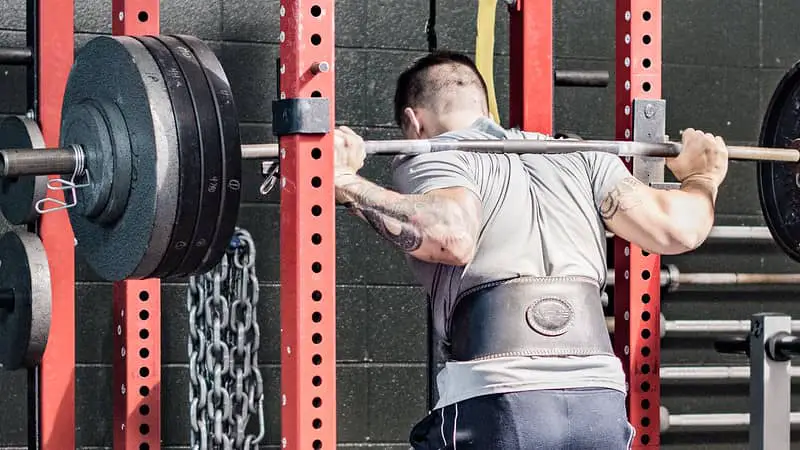
While rucking can contribute to leg strength and endurance, it should not replace leg day exercises due to differences in muscle isolation, movement variety, weight customization, and time efficiency, all of which are crucial for comprehensive leg muscle development and balanced fitness.
Why Rucking Should Not Replace Leg Day
Leg days in the gym are dedicated to growing your leg muscles (quads, hamstrings, and calves). While rucking has a lot of benefits and does increase strength, it should not be replacing leg day at the gym.
Here are 5 reasons why rucking should not replace leg day if for rucking:
- Leg days and workouts are more isolated: doesn’t target specific leg muscles to the same degree as focused leg exercises like squats, lunges, and leg presses. Leg day exercises allow for better muscle isolation, which is important for balanced muscle development.
- Leg days have more movement variety than Rucking: Rucking involves the same motion and movement. This means that it’s not providing us ruckers with the same controlled progression that we’d get from a proper leg day. Leg day workouts include different movements like squats, lunges, revers lunges, etc which target different parts of the legs.
- Weight Customization: Leg day exercises allow you to adjust the weight according to your fitness level and goals. With rucking, the weight is often limited to what you can comfortably carry in a backpack, which might not provide enough resistance for advanced lifters.
- Time Efficiency: Leg day workouts can last 30 minutes and you can get everything out of it if done correctly. The right amount of muscle activation and overload in a short period of time. Whereas with rucking, it’s difficult to get a good leg workout from 30 minutes of rucking.
Based on personal experience, I found that solely relying on rucking to grow my legs did not go as planned. I found that after rucking, I was able to ruck with much higher weights. Meaning my legs gained strength.
However, my legs (quads, hamstrings, and calves) saw little to no growth.
Importance of Leg Day When it Comes to Rucking
Before discussing whether rucking can or should replace leg day, we should understand why leg day is important and how it helps us in our rucks before making that decision.
Leg Days are important for the following reasons:
| Benefit of Leg Day | Importance for Rucking |
|---|---|
| Strength and Muscle Development | Provides the strength needed to carry a weighted backpack during rucking. |
| Balanced Physique | Ensures all muscle groups work harmoniously, reducing risk of injury. |
| Metabolic Boost | Sustains energy expenditure needed for long-duration rucking. |
| Joint Stability and Injury Prevention | Stabilizes joints, reducing overuse injury risk during rucking. |
| Bone Health | Supports bones during heavy weighted rucks. |
| Enhanced Circulation | Improves blood flow, reducing discomfort during rucking. |
| Athletic Performance | Boosts power and efficiency in rucking for ruck events or challenges. |
Importance of Leg day for rucking explained
- Strength & Muscle Development: Leg workouts such as squats are very important for functional movements and overall physical performance. The majority of muscles in your body are in your legs (these muscles are also the most powerful as they are responsible for carrying your entire body).
- Balanced Physique: Have you ever seen those who skip leg days in the gym? their upper body’s are massive but have skinny legs (also known as chicken legs). Not only aesthetically awkward, but it can result in poor posture and increases risk of injuries.
- Metabolic Boost: Since leg muscles are the biggest in your body, working them out requires high levels of energy. The more energy exerted, the more calories you burn which boosts your metabolism.
- Joint Stability & Injury Prevention: Strong legs are needed to provide stability to the hip, knee, and ankle joints, which is needed during rucking as they are used constantly.
- Bone Health: Well-muscled legs protect your bones during heavy lifting activities which include rucking.
How Does Rucking Contribute to Leg Muscle Development?
Rucking develops your leg muscles by:
- Constant Resistance Training: The weight in the backpack provides constant resistance which challenges your legs and forces them to work hardr leading to led muscle growth and development.
- Endurance & Stamina: Rucking is done over long distance which forces your hamstrings, quads and calves to work through different terrains at a constant pace.
If your primary goal is significant leg muscle growth, incorporating a variety of leg day exercises with progressive resistance is recommended. Rucking can be a valuable addition to your routine, providing cardiovascular benefits, endurance, and a unique form of leg engagement. Combining both approaches can help you achieve a balanced and effective leg training regimen.
Is Rucking A Good Leg Workout?
Rucking is considered a good leg workout as it used heavily to drive your bodyweight and the weight of the backpack up and downhill. However, it may not fully replace dedicated leg day exercises for certain goals.
Rucking engages various leg muscles, including the quadriceps, hamstrings, and calves, due to the constant resistance provided by the weighted backpack. This leads to muscle activation, endurance, and strength development, making rucking an effective form of functional leg exercise.
